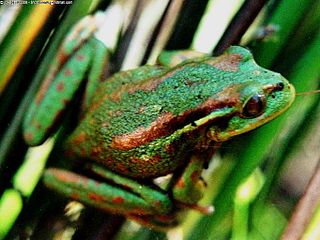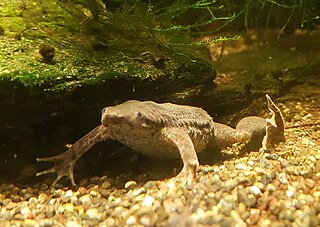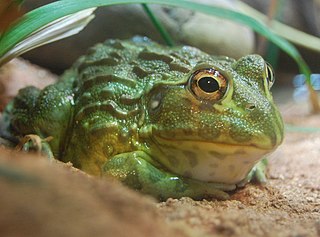
The Pipidae are a family of primitive, tongueless frogs. There are 41 species in the family, found in tropical South America and sub-Saharan Africa.

Suriname toads are members of the frog genus Pipa, within the family Pipidae. They are native to northern South America and extreme southern Central America (Panama). Like other pipids, these frogs are almost exclusively aquatic.

The Rhinophrynidae are a family of frogs containing one extant genus, the monotypic Rhinophrynus, and a number of fossil genera. The family is sometimes known as the Mexican burrowing toads or simply burrowing toads.

African dwarf frog is the common name for members of Hymenochirus, a genus of aquatic frog native to parts of Equatorial Africa. They are common in the pet trade and are often mistaken for the African clawed frog, a similar-looking frog in the same family. African dwarf frogs are also known as dwarf clawed frogs. Their common name is obtained from their place of origin and the claws on their hind legs.

Hymenochirus boettgeri, also known as the Zaire dwarf clawed frog or the Congo dwarf clawed frog, is a species of frog in the family Pipidae. It is found in Nigeria, Cameroon, Equatorial Guinea, Gabon, and east to the Central African Republic and to eastern Democratic Republic of the Congo. It presumably occurs in the Republic of the Congo but has not been recorded there. It is a common species over most of its wide range and the International Union for Conservation of Nature has assessed its conservation status as being of least concern.
Hyperolius soror is a species of frog in the family Hyperoliidae. It is endemic to Guinea as it is known with certainty only from Nzérékoré in the southern part of the country, although it is likely that it occurs in adjacent Liberia and western Ivory Coast. Common name soror reed frog has been coined for this species.
Kassina fusca is a species of frog in the family Hyperoliidae. Its common name is brown running frog or pale running frog. It is found in the West African savanna zone in Senegal, Gambia, Guinea, Mali, Burkina Faso, Ivory Coast, Ghana, Togo, Benin, Niger, and Nigeria. It probably occurs in Guinea-Bissau, although there are no records from there.

Hylorina sylvatica is a species of frog in the family Batrachylidae. It is monotypic within the genus Hylorina. It is found in Argentina and Chile. This species is endemic to the austral Nothofagus forests of Chile and Argentina with a narrow distribution along the eastern slopes of the Andes.

The Petropedetidae are a family of frogs containing three genera and 12 species. They are found in sub-Saharan tropical Africa and are sometimes known under common name African torrent frogs.
Hymenochirus boulengeri, also known as eastern dwarf clawed frog, is a species of frog in the family Pipidae. It is endemic to northeastern Democratic Republic of the Congo where it is only known from two localities. It is presumably ecologically similar to Hymenochirus boettgeri, an aquatic frog that occurs in still, shaded water in lowland rainforest, and in pools by slow-flowing rivers. Threats to this little-known species are unknown.
Hymenochirus curtipes, also known as western dwarf clawed frog, is a species of frog in the family Pipidae. It is found in western Democratic Republic of the Congo and adjacent Republic of the Congo. It is likely to occur in the southernmost Central African Republic.

Hymenochirus feae, also known as Gaboon dwarf clawed frog, is a species of frog in the family Pipidae. It is endemic to Gabon and is only known with certainty from its type locality on the coast of central Gabon. The specific name feae honors Leonardo Fea, an Italian explorer, zoologist, and naturalist.

Pipa parva, is a species of frog in the family Pipidae. It is found in northwestern Venezuela and northeastern Colombia, mainly in the Maracaibo Basin. There is an introduced population in the Lake Valencia Basin in northern Venezuela.
Xenopus boumbaensis, the Mawa clawed frog, is a species of frog in the family Pipidae. It is known from a few localities in central and south-eastern Cameroon, and from north-western Republic of Congo and extreme south-western Central African Republic; it probably occurs more widely in the central African forest belt, but identification is difficult: it is one of the cryptic species that resemble Xenopus fraseri, from which it can be distinguished by chromosome number (2n=72) and a male advertisement call of a single note.

Hyloidea is a superfamily of frogs. Hyloidea accounts for 54% of all living anuran species. The superfamily Hyloidea branched off from its closest relative, the Australobatrachia, during the mid-Cretaceous. The fossil evidence found during the Cretaceous-Paleogene extinction event could not determine the effects upon the frogs, due to the lack of fossils. Increased forestation erupted after this extinction, possibly leading to more arboreal adaptations of these anurans to be best suited for this habitat.

The Pyxicephalidae are a family of frogs currently found in sub-Saharan Africa. However, in the Eocene, the taxon Thaumastosaurus lived in Europe.

Craugastoridae, commonly known as fleshbelly frogs, is a family of New World direct-developing frogs. As delineated here, following the Amphibian Species of the World, it contains 129 species. They are found from the southern United States southwards to Central and South America.

Odontobatrachus is a genus of frogs comprising the family Odontobatrachidae. In a 2014 research project Barej, Rödel, Loader & Schmitz separated the genus from the established genus Petropedetes and separated the new family from the established family Petropedetidae.













